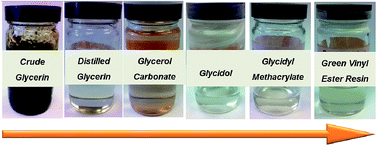Environmentally benign synthesis of vinyl ester resin from biowaste glycerin†
Abstract
We present here for the first time a novel environmentally benign protocol for the synthesis of vinyl ester resin (VER). Our synthetic strategy utilizes a commercial waste material, glycerin, from biodiesel manufacturing and converts it into a widely utilized resin. The VER was synthesized using bisphenol A (BPA) and glycidyl methacrylate (GMA) as precursors. GMA was synthesized via a multistep synthetic protocol using glycerin obtained from a biodiesel manufacturing waste stream. The structure of the intermediates was confirmed by 1H NMR, HPLC and FT-IR spectroscopy.


 Please wait while we load your content...
Please wait while we load your content...